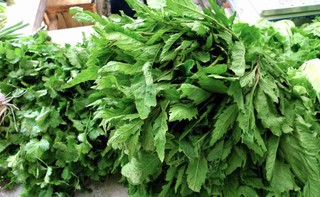15 rare herbs you should consider growing in your garden
- 1. Anise hyssop (Agastache foeniculum)
- 2. Borage (Borago officinalis)
- 3. Epazote (Dysphania ambrosioides)
- 4. Fairywand (Chamaelirium luteum)
- 5. Feverfew (Tanacetum parthenium)
- 6. French sorrel (Rumex scutatus)
- 7. Lettuce-leaf basil (Ocimum basilicum)
- 8. Lovage (Levisticum officinale)
- 9. Marsh-mallow (Althaea officinalis)
- 10. Saffron (Crocus sativus)
- 11. Stevia (Stevia rebaudiana)
- 12. Sweet cicely (Myrrhis odorata)
- 13. Toothache plant (Acmella oleracea)
- 14. Tulsi (Ocimum tenuiflorum)
- 15. Vietnamese coriander (Persicaria odorata)
- Conclusion

If you take a look at most herb gardens, you’ll notice the usual suspects: cilantro, rosemary, oregano, thyme, parsley, sage, basil, and mint. These plants are popular as culinary herbs, and the need for them in many of your “usual” recipes. Adding rare herbs to your herb garden can introduce you to new flavors and add a little spice to your garden.
The following unusual herbs are fun, interesting plants to try in your herb gardening adventures.

1. Anise hyssop (Agastache foeniculum)
With a flavor similar to anise, the herb anise hyssop is a bit of a misnomer as it is neither anise seed or hyssop or a blend of the two. A member of the mint family, this herb adds a mild, minty, licorice flavor to salads and vegetable dishes. Fresh or dried leaves can be made into tea while the seeds are used as a substitute for anise in baking. Impressive spikes of lavender blossoms add an aesthetic touch to your herb garden.
Anise hyssop can be grown with almost any other herbs, including the alliums such as chives and garlic. Keep the growing media moist until plants are well established. You can then allow the soil to dry out slightly between watering.
2. Borage (Borago officinalis)
Also known as starflower, borage’s cucumber flavored leaves are commonly used for teas and other beverages. The bright, star-shaped blue flowers make an eye-catching garnish for salads, open-faced sandwiches, and dips while adding a hint of flavor. Their flavor diminishes when dried, so use them fresh.
Borage needs full sun and is susceptible to root rot when the soil is kept too moist.

3. Epazote (Dysphania ambrosioides)
Known for its pungent flavor, epazote is often used in Mexican dishes and traditional medicine. Epazote is believed to help regulate digestion, lessen stomach cramps, and aid with gas and bloating. Due to this, it is commonly used for flavoring dishes containing black beans.
Avoid consuming large quantities of epazote. The flowers and seeds can cause nausea and convulsions when eaten in excess.[1]
4. Fairywand (Chamaelirium luteum)
Native to Eastern North America, fairywand is also known as angel’s fishing rod because of its arching, plume-like spikes of tiny, densely-packed white or pink flowers. The herbaceous perennial plant is widely used by Native Americans as a “woman’s herb” to treat menstrual problems and improve fertility.
Plants are drought tolerant and can be started from seed, but dividing rhizomes is the preferred propagation method.
5. Feverfew (Tanacetum parthenium)
A perennial plant belonging to the daisy family, and closely resembling chamomile, feverfew is used throughout the world as a traditional medicinal herb to treat and prevent migraines. Small daisy-like flowers are white with bright yellow centers; the feathery leaves are said to give off a citrus smell, helping to repel bees.
Feverfew likes well-drained potting soils but doesn’t tolerate dry conditions. Keep an eye on it if allowed to go to seed as it reseeds liberally and can become invasive.

Feverfew, photo: LearningLark

The enthusiast's guide to herbs
We’re proud to present our new e-book, The Enthusiast’s Guide to Herbs! Learn everything you need to know about growing and caring for herbs indoors, including in-depth info cards for the 35 most commonly grown herbs.
Click the link below to find out more!
6. French sorrel (Rumex scutatus)
The lance-shaped leaves of the french sorrel plant grow 6 to 12-inches in length, lending themselves to use similarly to spinach in many dishes where an acidic, citrus taste is wanted. Homeopathically it is used as an anti-inflammatory to treat sudden-onset and chronic pain.
French sorrel develops a long taproot, so it does best when grown in deep containers, and the potting mix is allowed to dry out slightly between waterings.
7. Lettuce-leaf basil (Ocimum basilicum)
Yes, yes. Basil itself isn’t an unusual or rare herb to grow, but lettuce-leaf basil is a lesser-known variety that warrants being included in this list. Brilliantly green leaves grow up to 5 inches long and have a crinkled appearance like lettuce leaves. The milder, sweet flavor makes them excellent for wrapping chicken or fish for grilling, and their large size and subdued taste lend themselves for use in salads or on sandwiches.
Lettuce leaf basil likes full sun and to be kept consistently moist, but avoid overwatering as plants are susceptible to soil-borne fungal diseases that quickly kill young plants.
8. Lovage (Levisticum officinale)
If you’re looking for an herb with a plentitude of uses, definitely add lovage to your herb garden! With a bright and fresh celery flavor, leaves can be added to salads, or used in place of parsley in your favorite recipes. The lovage seeds - what we surprisingly know as celery seeds - are used to flavor marinades, soups, chilis, and dips.
Lovage loves full sun locations and well-draining soil, like many other herbs. Keep the potting mix moist without being overly soggy and avoid getting water on the leaves when watering plants.

9. Marsh-mallow (Althaea officinalis)
Marshmallow plants are commonly sold as herbal medicines as the Greek word “althos” means “healing”. The plants grow in tall, elegant spikes with flowers in pale pinks or white. Roots of the marsh-mallow plant contain mucilage, a gelatinous substance used by the French to create a confection that has morphed into what we know today as the fluffy, white marshmallow.
Plant your marsh-mallow in a loose growing media or add extra sand to a standard potting mix. They prefer moist soils and full sun.
10. Saffron (Crocus sativus)
Made from the purple saffron crocus plant, an autumn blooming crocus, saffron is the world’s most expensive spices. The enigmatic spice comes from the bold, threadlike red stigmas produced by the plant and imparts a characteristic yellow hue to rice dishes and paella. Plants only produce three stigmas per flower and bloom for a week, leading to an incredibly high price tag.
Saffron needs well-draining soil that is moderately rich in organic matter, and full sun or the bulbs will rot.
11. Stevia (Stevia rebaudiana)
Stevia has made itself well known in the recent health push to reduce sugar consumption by using natural, alternative products. The leaves on a stevia plant are 30 times sweeter than sugar and can be used either fresh or dried. A single plant can yield up to ½ pound of dried, calorie-free leaves.
Stevia plants grow well in containers but like their space. Don’t plant more than 1 or 2 plants per container, when in the ground they like 18-inches between plants. Once flowers appear, make sure to harvest the entire plant before more than a handful open.

12. Sweet cicely (Myrrhis odorata)
Widely cultivated in the past to relieve stomach aches and coughs, sweet cicely isn’t found in many herbs gardens any longer. The sweet anise-flavored leaves can be cooked like spinach or used raw in salads or egg dishes. Stalks can be chopped and used similarly to celery, and the roots are often boiled or used to make wine.
Avoid planting sweet cicely near parsley as they attract the same insect pests. Remove flower blooms before they set seeds to prevent plants from spreading voraciously.
13. Toothache plant (Acmella oleracea)
Just as the name suggests, the toothache plant has been grown for centuries to ease toothaches’ pain. The leaves or attractive golden yellow flowers can be chewed for a few seconds to induce a tingling or numbing sensation in your mouth.
Keep the soil moderately moist when growing a toothache plant, avoiding waterlogged roots.

14. Tulsi (Ocimum tenuiflorum)
Also known as holy basil, tulsi is a highly revered herb in Hinduism and grown across most of the Indian subcontinent. It is one of the most preeminent herbs in Ayurvedic medicine. Tulsi’s essential oils, paste, and powder have numerous confirmed beneficial effects. These include normalizing blood pressure, lipid levels, and blood glucose, improving memory and cognitive function, acting as an antidepressant well as possessing broad-spectrum antimicrobial activity.[2]
Treat tulsi as an annual, making sure to keep the soil moist without letting it get waterlogged or overly dry. Like other herbs, plants prefer fertile, well-drained soil and full sun.
15. Vietnamese coriander (Persicaria odorata)
Vietnamese coriander has a taste similar to the American grown cilantro but can withstand much hotter summertime temperatures without bolting. It is commonly used in Southeast Asian dishes as a replacement for peppermint and has a very strong, smoky flavor.
Keep the soil moist at all times and avoid planting it in a container with other herbs. It’s creeping nature causes it to grow into a ground cover, taking over any available space and pushing out other plants.
Conclusion
Growing herbs you are familiar with or will use in the kitchen is a great way to start an herb garden, but those constraints do not limit you. Adding rare or unusual herbs to your collection can bring variety and aesthetic value to your assortment while opening up a world of new culinary flavors and natural remedies.

Join our email club—get printable info cards free!
Sign up to receive our newsletter and get access to 10 printable plant info cards from our e-book for free. Also receive:
- $4 discount code for our Guide to Herbs e-book
- Semi-weekly plant inspiration & bite-size tips and tricks
https://cals.arizona.edu/fps/sites/cals.arizona.edu.fps/files/cotw/Epazote.pdf ↩︎
Cohen M. M. (2014). Tulsi - Ocimum sanctum: A herb for all reasons. Journal of Ayurveda and integrative medicine, 5(4), 251–259. doi: 10.4103/0975-9476.146554 ↩︎
